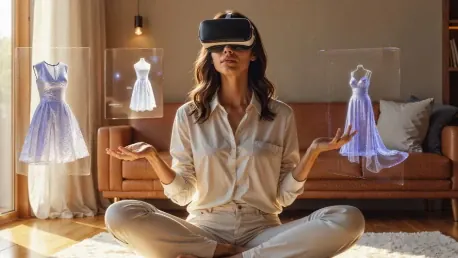Augmented reality (AR) is revolutionizing the retail industry by merging the physical and digital shopping environments. This technology is not just a novelty; it is becoming an essential tool for retailers to enhance customer engagement, improve shopping experiences, and drive sales. As consumer interest in AR grows, its applications in retail are expanding, offering both practical utility and immersive experiences.
Rising Interest and Adoption of AR
Consumer Interest in AR
Consumer interest in AR is significantly on the rise, with a notable 66% of consumers expressing a desire to use AR for making purchasing decisions. This growing interest is expected to lead to widespread adoption, as projections indicate that by 2025, nearly 75% of the global population and almost all smartphone users will be frequent AR users. Supporting this trend is a 2019 Nielsen global survey, which found that consumers ranked AR and virtual reality (VR) as the top technologies they seek to assist them in daily life. This demonstrates a clear preference for these immersive technologies and suggests they have the potential to become integral parts of everyday shopping.
This burgeoning interest among consumers has not gone unnoticed by retailers, who are increasingly integrating AR into their business strategies. The adoption of AR is not limited to brick-and-mortar stores; both physical and e-commerce platforms are exploring its possibilities. AR provides a seamless blend of the physical and digital realms, allowing customers to have enriched, interactive shopping experiences. This technology can bridge the gap between online and offline shopping, provide a more engaging experience, and ultimately enhance customer satisfaction and loyalty. Major retailers already leveraging AR illustrate its ability to transform the shopping experience, driving both customer engagement and sales.
Retailers Embracing AR
Retailers across various sectors are recognizing the immense potential of AR to transform the shopping experience, leading to more engaging and interactive environments. By integrating AR into their strategies, businesses can create a more cohesive and enriched shopping journey that captivates customers and encourages spending. This technology allows retailers to bridge the gap between their physical and digital presence, providing a seamless experience that combines the best of both worlds.
Major retailers are already leveraging AR to enhance customer interactions and drive sales. Innovators like IKEA have adopted AR through their IKEA Place app, which enables customers to visualize how furniture would look in their homes. Similarly, beauty retailers like Ulta Beauty are using shoppable AR filters on platforms like Snapchat to engage customers with virtual makeup try-ons. These examples demonstrate that AR is not just a trend but a valuable tool that enhances the shopping experience. As the technology becomes more prevalent and accessible, it is expected that an increasing number of retailers will incorporate AR into their business models to meet evolving consumer expectations and stay competitive in the market.
Understanding Augmented Reality
What is Augmented Reality?
Augmented reality is a groundbreaking technology that overlays digital content on real-life objects in real-time, creating an immersive and interactive experience. This is achieved through the use of depth tracking and computer vision, which analyze video streams and recognize objects, allowing digital content to dynamically interact with the physical environment. The ability to seamlessly blend the digital and physical worlds makes AR a powerful tool for enhancing customer experiences and product interactions in both brick-and-mortar businesses and direct-to-consumer brands.
The applications of AR in retail are vast and varied, providing customers with an enriched shopping experience that goes beyond traditional methods. For instance, AR allows customers to visualize products in their own environment, try on virtual clothing or accessories, and receive detailed product information in real-time. This has the potential to remove uncertainties and improve the overall decision-making process, making shopping more convenient, informative, and enjoyable. The implementation of AR technology in retail not only benefits consumers but also provides businesses with valuable insights into customer behavior, helping them to tailor their offerings and enhance customer satisfaction.
How AR Works
AR technology operates by using cameras and sensors to capture the real world and then overlaying digital information on top of it, creating a blended experience that enhances the perception of reality. This process involves depth tracking, which measures the distance between the camera and objects, and computer vision, which identifies and processes visual data. By continuously analyzing the surroundings, AR systems enable digital content to interact seamlessly with the physical world, offering users an enriched and engaging experience.
Practical applications of AR in retail range from virtual try-ons and in-store navigation to interactive displays and digital fitting rooms. For example, AR can guide customers through a store, helping them locate products and providing additional information about items, such as reviews or complementary products. This level of interaction and assistance can greatly enhance the shopping experience, making it more efficient and enjoyable. Additionally, AR enables the creation of interactive advertisements and displays that captivate customers’ attention and provide real-time analytics, allowing retailers to optimize their marketing strategies and adjust content dynamically based on customer engagement.
Benefits of AR in Retail
Customer Engagement and Experiential Retail
AR creates immersive shopping experiences that drive customer engagement and increase education about products. These interactive experiences not only captivate customers but also provide valuable information that can influence purchasing decisions. For instance, Starbucks’ in-store AR experience demonstrates the journey of a coffee bean, engaging customers in a unique and informative way. By providing an engaging and educational aspect to the shopping experience, AR helps in building a deeper connection between customers and brands, fostering loyalty and repeat business.
Experiential retail, powered by AR, is becoming a key strategy for businesses seeking to differentiate themselves in a competitive market. The use of AR allows retailers to create novel and memorable experiences that encourage customers to spend more time in-store or on their e-commerce platforms. This increased engagement often translates into higher sales and conversion rates, as customers are more likely to make purchases when they feel a personal connection to the brand and its products. Furthermore, the interactive nature of AR experiences often leads to customers sharing their experiences on social media, providing organic marketing and enhancing brand visibility.
Sales and Conversion Lifts
The impact of AR on sales and conversion rates is substantial, with data indicating that merchants using 3D content see an impressive average of 94% conversion lift. This significant increase in conversion rates can be attributed to the enhanced shopping experience that AR provides, allowing customers to visualize products in their own environment and make more informed decisions. By bridging the gap between online and offline shopping, AR helps to mitigate the uncertainties often associated with online purchases, providing a more confident and satisfying shopping experience.
AR’s ability to drive sales and conversions is not limited to e-commerce; it also has a profound impact on in-store shopping. Retailers can use AR to create interactive displays and demonstrations that capture customers’ attention and encourage them to explore products further. By providing additional information and a more engaging shopping environment, AR enhances the overall customer experience, increasing the likelihood of purchases. As retailers continue to integrate AR into their strategies, it is expected that the technology will play an increasingly important role in driving sales and improving conversion rates across various retail channels.
Contactless Experiences
The COVID-19 pandemic has accelerated the adoption of contactless shopping experiences, and AR plays a crucial role in this shift. AR allows customers to evaluate products virtually, reducing the need for physical contact. This capability is invaluable in maintaining health and safety standards during times when minimizing contact is a priority. By offering contactless experiences, AR helps to build customer confidence and trust, as they can shop safely without compromising on the quality of the experience.
Contactless AR experiences extend beyond merely evaluating products; they also enable virtual try-ons, digital fitting rooms, and remote product demonstrations. These innovations allow customers to interact with products in a meaningful way without the need for physical engagement. Retailers can leverage this technology to provide personalized and convenient shopping experiences, catering to customers’ preferences for safety and convenience. This shift towards contactless AR experiences is expected to continue even after the pandemic, as consumers have become accustomed to the convenience and enhanced safety that these technologies provide.
Sharable and Trackable Content
AR-powered filters and displays serve as organic marketing tools while providing vital customer insights and driving revenue. For example, Ulta Beauty’s shoppable AR filters on Snapchat allow users to try on virtual makeup looks and share photos, while integrating real-time product details. This not only enhances the shopping experience but also generates sharable content that can attract new customers. By encouraging users to share their AR experiences on social media, retailers can amplify their reach and influence, leveraging user-generated content as a powerful marketing tool.
In addition to being sharable, AR content is highly trackable, providing retailers with valuable data and insights into customer behavior and preferences. This information can be used to refine marketing strategies, personalize customer interactions, and optimize product offerings. The ability to track customer engagement with AR experiences also allows retailers to measure the effectiveness of their AR initiatives, making it possible to make data-driven decisions and continuously improve the shopping experience. As AR technology continues to evolve, its ability to generate and utilize shareable and trackable content will become an increasingly important asset for retailers looking to stay competitive in a rapidly changing market.
Use Cases of Augmented Reality in Retail
Virtual Shopping
Platforms like Snapchat and Instagram allow users to overlay digital images and accessories in real-time for virtual try-on experiences, enhancing the online shopping experience. Retailers such as Ray-Ban, Nike, Kendra Scott, and Amazon have adopted AR-powered try-on tools, allowing customers to see how products will look on them before making a purchase. For instance, IKEA’s IKEA Place app enables customers to visualize how furniture would look in their homes, significantly reducing uncertainties and making it easier to make purchasing decisions.
Virtual shopping through AR provides an engaging and personalized experience that goes beyond traditional online shopping. By allowing customers to interact with products in a virtual environment, AR helps to build confidence in their purchasing decisions and enhances satisfaction. This approach not only improves the online shopping experience but also helps to bridge the gap between online and offline retail, providing a more cohesive and seamless customer journey. As more retailers adopt AR-powered virtual shopping tools, the technology is set to become a standard feature in e-commerce, offering customers a more interactive and informed shopping experience.
Virtual Navigation
AR systems provide navigation assistance within brick-and-mortar stores, further enriching the shopping experience by guiding customers to specific products, offering information about items, and even suggesting complementary products. By incorporating AR navigation, retailers can create a more efficient and personalized shopping journey, helping customers to easily find what they are looking for and discover new items. This not only enhances the convenience of shopping but also increases the likelihood of additional purchases, as customers are exposed to more products and recommendations.
The implementation of AR navigation systems can transform the in-store experience, making it more interactive and engaging for customers. These systems can provide real-time information and updates, ensuring that customers have access to the latest product details and promotions. By offering a more connected and informative shopping experience, AR navigation helps to build customer loyalty and encourages repeat visits. As technology advances, it is expected that more retailers will integrate AR navigation into their strategies, providing a more streamlined and enjoyable shopping experience for their customers.
In-Store Displays
Augmented reality displays offer eye-catching interactive advertisements, track real-time analytics, and can dynamically update content, capturing customer interest and providing valuable data for optimizing marketing strategies. For example, PacSun’s AR storefront campaign featuring Emma Chamberlain attracted significant attention and engagement, demonstrating the potential of AR displays to create memorable and impactful marketing experiences. These displays not only enhance the visual appeal of stores but also provide an interactive element that engages customers in a unique way.
AR in-store displays can showcase products, provide additional information, and even offer interactive experiences that allow customers to interact with the brand and its products. By integrating AR into their physical stores, retailers can create a more immersive and engaging shopping environment that captures customers’ attention and encourages exploration. This approach not only enhances the in-store experience but also provides valuable insights into customer behavior and preferences, allowing retailers to tailor their offerings and improve overall satisfaction.
Virtual Fitting Rooms
Augmented reality (AR) is transforming the retail industry by blending the physical and digital shopping worlds. This technology is far from just a novelty; it’s swiftly becoming a vital tool for retailers looking to boost customer engagement, enhance shopping experiences, and increase sales. As consumer interest in AR continues to rise, its applications in retail are also expanding, offering practical benefits alongside immersive experiences.
Retailers are leveraging AR to provide virtual try-ons for clothing and accessories, allowing customers to see how products will look and fit without ever stepping into a dressing room. This not only creates a fun and engaging shopping experience but also helps reduce return rates by allowing customers to make more informed purchasing decisions. Additionally, AR is being used to create interactive and dynamic in-store displays, where customers can scan products with their smartphones to receive additional information, reviews, and promotional offers.
Furthermore, AR enhances online shopping by providing 3D visualizations of products that customers can view from every angle in their own environment. This is particularly beneficial for furniture and home decor items, as it allows customers to see how products will fit and look in their space before making a purchase. As AR technology continues to evolve, innovative applications will undoubtedly emerge, further solidifying its role as a crucial component of the future of retail.









